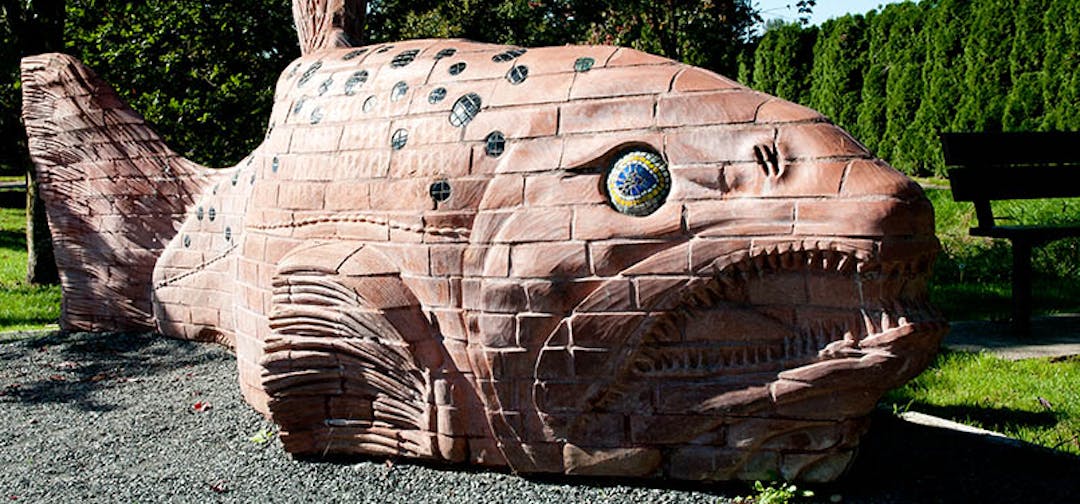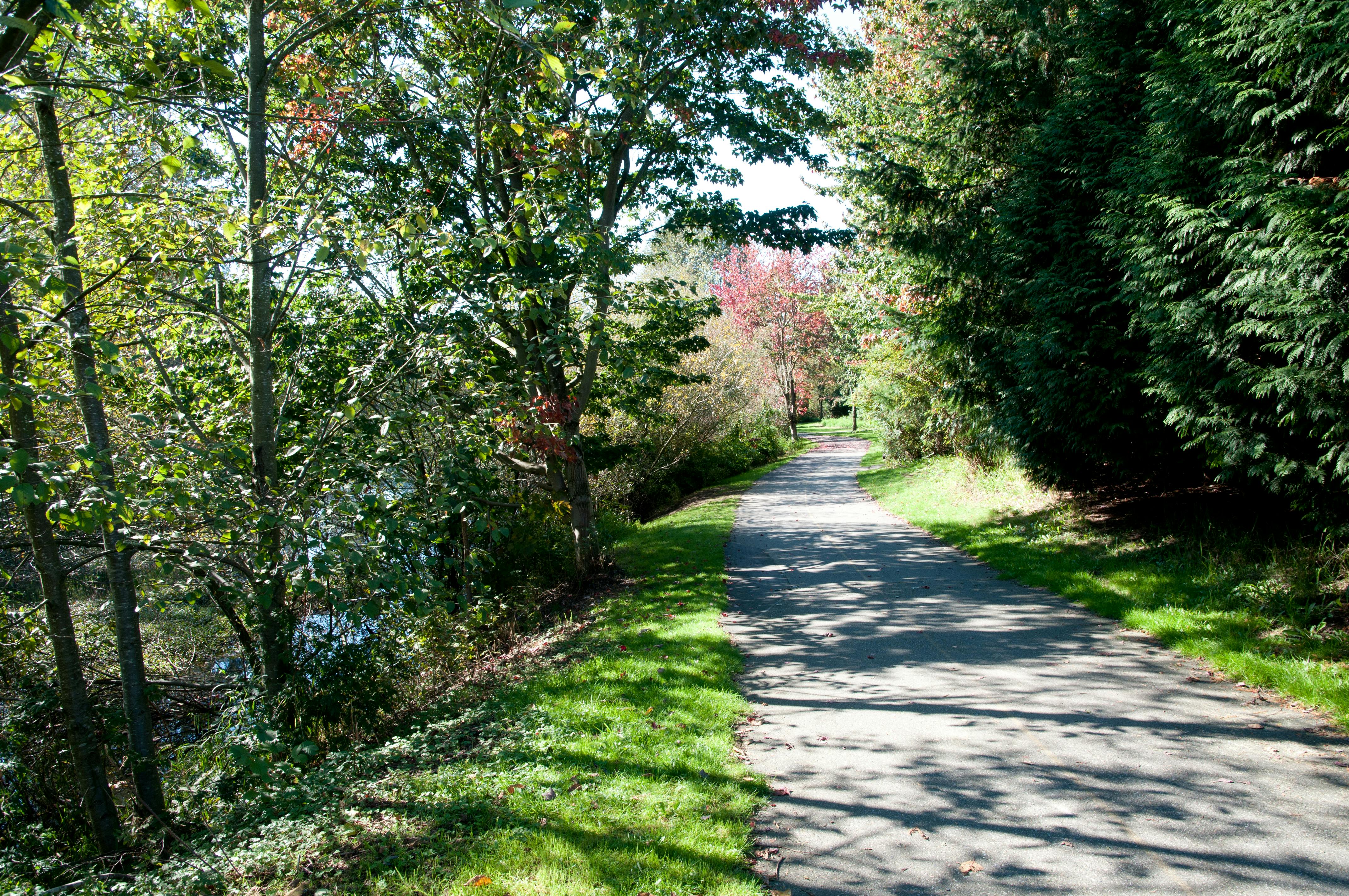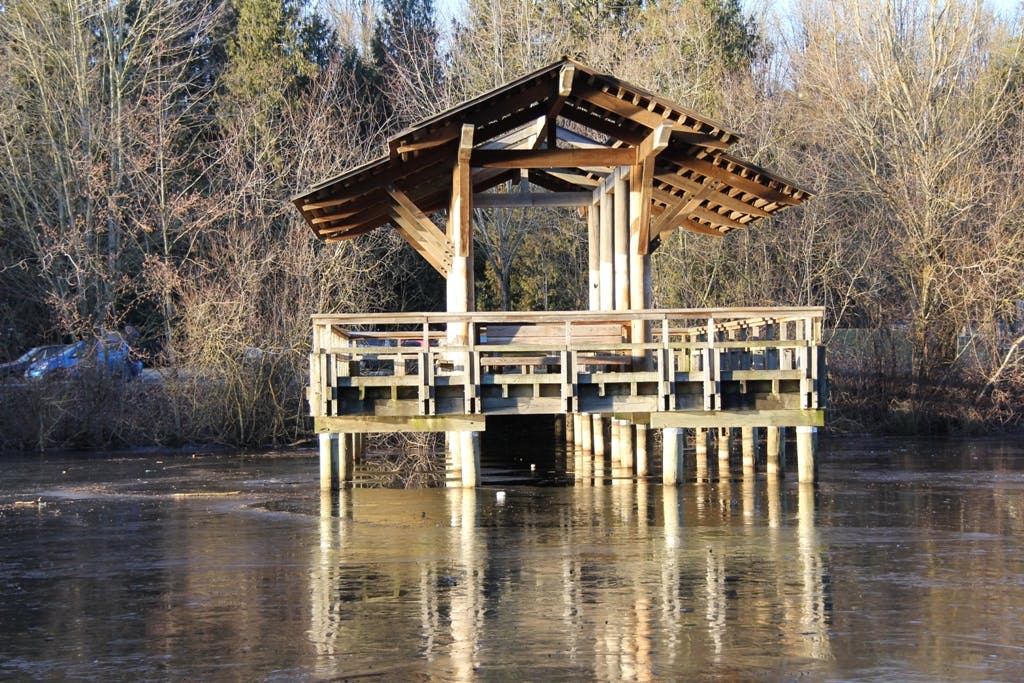Fishtrap Creek - Integrated Stormwater Management Plan (ISMP)

The Fishtrap Creek watershed is located in the southwest portion of the City, running west beyond Ross Road, north to Blueridge Drive and east to Trethewey Street. The Fishtrap Creek detention area was originally built as a large stormwater management facility to minimize the downstream flooding caused by development. This greenspace has been impacted by development and agricultural activities.
The City is putting together a plan for this area that will work to resolve some of the issues such as flooding, poor drainage, overgrowing vegetation, fish and wildlife habitat loss and poor water quality.
View the Fishtrap Creek ISMP Project Update – Stage 3 Draft Plan and if you have any questions, please ask your question below!
The Fishtrap Creek watershed is located in the southwest portion of the City, running west beyond Ross Road, north to Blueridge Drive and east to Trethewey Street. The Fishtrap Creek detention area was originally built as a large stormwater management facility to minimize the downstream flooding caused by development. This greenspace has been impacted by development and agricultural activities.
The City is putting together a plan for this area that will work to resolve some of the issues such as flooding, poor drainage, overgrowing vegetation, fish and wildlife habitat loss and poor water quality.
View the Fishtrap Creek ISMP Project Update – Stage 3 Draft Plan and if you have any questions, please ask your question below!
Ask us a Question!
Let us know if you have a question about this project!
-
Share On February 1, 2020, after a couple days of heavy rain, water from the pond flooded the park pathways in multiple locations. The worst affected area was Dehavilland Place, where the flood was bordering peoples’ backyards. With each heavy rain, the floods are becoming more and more severe. My question is about the timeline. When is the planning process going to be completed and the solution executed? Thank you. on Facebook Share On February 1, 2020, after a couple days of heavy rain, water from the pond flooded the park pathways in multiple locations. The worst affected area was Dehavilland Place, where the flood was bordering peoples’ backyards. With each heavy rain, the floods are becoming more and more severe. My question is about the timeline. When is the planning process going to be completed and the solution executed? Thank you. on Twitter Share On February 1, 2020, after a couple days of heavy rain, water from the pond flooded the park pathways in multiple locations. The worst affected area was Dehavilland Place, where the flood was bordering peoples’ backyards. With each heavy rain, the floods are becoming more and more severe. My question is about the timeline. When is the planning process going to be completed and the solution executed? Thank you. on Linkedin Email On February 1, 2020, after a couple days of heavy rain, water from the pond flooded the park pathways in multiple locations. The worst affected area was Dehavilland Place, where the flood was bordering peoples’ backyards. With each heavy rain, the floods are becoming more and more severe. My question is about the timeline. When is the planning process going to be completed and the solution executed? Thank you. link
On February 1, 2020, after a couple days of heavy rain, water from the pond flooded the park pathways in multiple locations. The worst affected area was Dehavilland Place, where the flood was bordering peoples’ backyards. With each heavy rain, the floods are becoming more and more severe. My question is about the timeline. When is the planning process going to be completed and the solution executed? Thank you.
Resident Of Abbotsford asked almost 6 years agoThank you for providing the information. Your information has been forwarded to the engineering consultant to incorporate into the technical analysis for exploring options. When the technical analysis is completed, mitigation options will be developed followed by assessing mitigation alternatives, public inputs, developing strategies, plan and report. The project is expected to be completed by Winter 2020/2021. Once the Final Report is adopted by Council, recommendations from the ISMP will be reviewed against other priorityitems identified in Drainage Master Plan for implementation.
-
Share Water detention areas are a great idea! In the context of climate change and wildlife habitat loss, many more will likely be needed. Are there currently stormwater "credits" for homeowners or developers that promote implementing stormwater buffers on their property? Buffers like: natural area conservation (i.e. protecting natural vegetation with minimal grading); disconnection of rooftop and non-rooftop runoff (i.e. switching to rain barrel/ rain garden water collection); reduction of concrete covering (i.e. reduced impervious surface on property), or other natural green infrastructure? If not, has research been done regarding successful homeowner/developer incentives done elsewhere to offset the cost for these things? My feeling is, if the city reduced the otherwise required structural stormwater systems to instead better manage stormwater at the source, it might be less to maintain for everyone. on Facebook Share Water detention areas are a great idea! In the context of climate change and wildlife habitat loss, many more will likely be needed. Are there currently stormwater "credits" for homeowners or developers that promote implementing stormwater buffers on their property? Buffers like: natural area conservation (i.e. protecting natural vegetation with minimal grading); disconnection of rooftop and non-rooftop runoff (i.e. switching to rain barrel/ rain garden water collection); reduction of concrete covering (i.e. reduced impervious surface on property), or other natural green infrastructure? If not, has research been done regarding successful homeowner/developer incentives done elsewhere to offset the cost for these things? My feeling is, if the city reduced the otherwise required structural stormwater systems to instead better manage stormwater at the source, it might be less to maintain for everyone. on Twitter Share Water detention areas are a great idea! In the context of climate change and wildlife habitat loss, many more will likely be needed. Are there currently stormwater "credits" for homeowners or developers that promote implementing stormwater buffers on their property? Buffers like: natural area conservation (i.e. protecting natural vegetation with minimal grading); disconnection of rooftop and non-rooftop runoff (i.e. switching to rain barrel/ rain garden water collection); reduction of concrete covering (i.e. reduced impervious surface on property), or other natural green infrastructure? If not, has research been done regarding successful homeowner/developer incentives done elsewhere to offset the cost for these things? My feeling is, if the city reduced the otherwise required structural stormwater systems to instead better manage stormwater at the source, it might be less to maintain for everyone. on Linkedin Email Water detention areas are a great idea! In the context of climate change and wildlife habitat loss, many more will likely be needed. Are there currently stormwater "credits" for homeowners or developers that promote implementing stormwater buffers on their property? Buffers like: natural area conservation (i.e. protecting natural vegetation with minimal grading); disconnection of rooftop and non-rooftop runoff (i.e. switching to rain barrel/ rain garden water collection); reduction of concrete covering (i.e. reduced impervious surface on property), or other natural green infrastructure? If not, has research been done regarding successful homeowner/developer incentives done elsewhere to offset the cost for these things? My feeling is, if the city reduced the otherwise required structural stormwater systems to instead better manage stormwater at the source, it might be less to maintain for everyone. link
Water detention areas are a great idea! In the context of climate change and wildlife habitat loss, many more will likely be needed. Are there currently stormwater "credits" for homeowners or developers that promote implementing stormwater buffers on their property? Buffers like: natural area conservation (i.e. protecting natural vegetation with minimal grading); disconnection of rooftop and non-rooftop runoff (i.e. switching to rain barrel/ rain garden water collection); reduction of concrete covering (i.e. reduced impervious surface on property), or other natural green infrastructure? If not, has research been done regarding successful homeowner/developer incentives done elsewhere to offset the cost for these things? My feeling is, if the city reduced the otherwise required structural stormwater systems to instead better manage stormwater at the source, it might be less to maintain for everyone.
Abby Resident asked over 6 years agoThese are great questions. In addition to rainwater detention for peak flow reduction, City of Abbotsford strongly encourages onsite source controls with innovative stormwater management approaches to reduce runoff volume, improve water quality, and to promote groundwater recharge, as outlined in the Development Bylaw, (Bylaw No. 2070-2011).
The City has initiated various studies for rainwater management, and completed a City-wide Drainage Master Plan (DMP) and three Integrated Stormwater Management Plans (ISMP) for Marshall, Downes and Clayburn watersheds. An ISMP for Willband Creek is in Stage 3 process and seeking public input in the form of an online survey. The ISMPs and DMP recommended onsite source controls including roof water infiltration into the ground via infiltration trenches and rock pits, roof leaders to rain barrels for reuse, bio-swales and rain gardens for treating runoff from paved surfaces (driveways and patios), pervious pavement for road runoff infiltration, absorbent soil in all pervious areas, and green roof for capture runoff, etc. These recommendations have been incorporated into drainage requirements through development application approval process. As incentives, the areas that drain to infiltration facilities could be deducted from detention storage volume calculations to encourage infiltration. For developments that provide rainwater infiltration of the entire site for 1 in 100-year events without a service connection, the Development Cost Charges for drainage could be waived.
Currently, the City is in the process updating the Subdivision Development Bylaw to include recommendations from the past ISMPs and Master Plan. The review will also look at best practices of rainwater management and green infrastructures implemented in other municipalities and seek public input whether the green approaches could be made amendatory to guide future developments and redevelopments.
The Drainage Master Plan completed in 2018 also recommended a Stormwater Fee and Charges Feasibility Study, which would further explore any additional incentives to encourage developers reducing runoff leaving development sites and property owners harvesting/ retrofitting rainwater on already developed sites, to further reduce costs of managing the stormwater system.
Currently, the Fishtrap Creek ISMP is in the Background Review and Date Assessment stage. By incorporating climate change factor, the ISMP will develop rainwater management strategies to achieve the goals of reducing runoff volume and peak flow, slowing down erosion process, reducing chance of flooding, and enhancing the environment along with other objectives.
Please stay tuned for the next update.
-
Share Is the city exploring any options for daylighting streams? I'm not so sure about East Abbotsford but around historic downtown large swathes of streams were diverted into sewage pipes (which as I'm sure you're well aware is not a good thing for our water treatment plants) so if there is troubles with flooding caused by poor drainage daylighting may just be a viable option. on Facebook Share Is the city exploring any options for daylighting streams? I'm not so sure about East Abbotsford but around historic downtown large swathes of streams were diverted into sewage pipes (which as I'm sure you're well aware is not a good thing for our water treatment plants) so if there is troubles with flooding caused by poor drainage daylighting may just be a viable option. on Twitter Share Is the city exploring any options for daylighting streams? I'm not so sure about East Abbotsford but around historic downtown large swathes of streams were diverted into sewage pipes (which as I'm sure you're well aware is not a good thing for our water treatment plants) so if there is troubles with flooding caused by poor drainage daylighting may just be a viable option. on Linkedin Email Is the city exploring any options for daylighting streams? I'm not so sure about East Abbotsford but around historic downtown large swathes of streams were diverted into sewage pipes (which as I'm sure you're well aware is not a good thing for our water treatment plants) so if there is troubles with flooding caused by poor drainage daylighting may just be a viable option. link
Is the city exploring any options for daylighting streams? I'm not so sure about East Abbotsford but around historic downtown large swathes of streams were diverted into sewage pipes (which as I'm sure you're well aware is not a good thing for our water treatment plants) so if there is troubles with flooding caused by poor drainage daylighting may just be a viable option.
That one Canuck asked over 6 years agoThank you for providing your input, and your suggestion will be forwarded to the ISMP team to further explore any options of daylighting streams.
The City of Abbotsford does not have a combined sewer system, which means that rain water and sanitary sewer are two separate systems. In general, runoff generated from roof areas and paved surfaces is either infiltrated into the ground or released slowly via detention, to downstream drainage pipes/ channels and eventually to watercourses after pre-treatment. Rainwater does not drain to the wastewater treatment plant or to the water treatment plant.
The integrated storm water management plans identify opportunities to improve urban drainage interface with the natural environment. This may include infiltrating drainage water back into the aquifer to provide base flows to creeks and streams and reducing peak flows from piped systems with engineered detention systems. Other opportunities may also include removing underground piping and daylighting which is essentially recreating a drainage path in green areas like parks and natural open spaces. Daylighting sometimes is not practical in the middle of historic downtown because the area is fully developed with buildings, streets, sidewalks and other features.
We will update this website with analysis and evaluation results at the end of Phase 2.
Who's listening
-
Phone 604-864-5514 Email kzhang@abbotsford.ca
Timeline
-
Stage 1 - Background Research
Fishtrap Creek - Integrated Stormwater Management Plan (ISMP) has finished this stageBackground Research and Baseline
-
Stage 2 - Exploring Options
Fishtrap Creek - Integrated Stormwater Management Plan (ISMP) has finished this stageVisioning, Issues and Analysis
-
Stage 3
Fishtrap Creek - Integrated Stormwater Management Plan (ISMP) is currently at this stageOptions Assessment, Feedback, and Draft Plan
-
Final Plan
this is an upcoming stage for Fishtrap Creek - Integrated Stormwater Management Plan (ISMP)Adoption of Final Plan
Document Library
-
 Stage 3 Documents
Stage 3 Documents
-
 Stage 2 Documents
Stage 2 Documents
-
 Stage 1 Documents
Stage 1 Documents
-
 2021-07-19 Committee of the Whole - Stages 1 _ 2 Overview (1.22 MB) (pdf)
2021-07-19 Committee of the Whole - Stages 1 _ 2 Overview (1.22 MB) (pdf)
-
 2021-09-30 Development Transportation _ Infrastructure Advisory Committee (1.18 MB) (pdf)
2021-09-30 Development Transportation _ Infrastructure Advisory Committee (1.18 MB) (pdf)
-
 2021-10-14 Agricultural Advisory Committee (1.18 MB) (pdf)
2021-10-14 Agricultural Advisory Committee (1.18 MB) (pdf)
-
 2021-09-16 Community Culture _ Environment Advisory Committee (1.18 MB) (pdf)
2021-09-16 Community Culture _ Environment Advisory Committee (1.18 MB) (pdf)
-
 Watershed Map (6.95 MB) (jpg)
Watershed Map (6.95 MB) (jpg)
-






